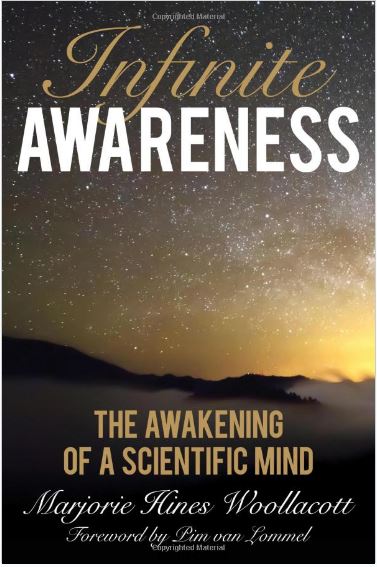 Infinite Awareness: The Awakening of a Scientific Mind by Marjorie Hines Woollacott
Infinite Awareness: The Awakening of a Scientific Mind by Marjorie Hines Woollacott
Reviewed by David Lorimer
Marjorie Woollacott has been a neuroscience professor at the University of Oregon for over thirty years and a meditator for even longer. Following the work of Eben Alexander and Pim van Lommel, who contributes the foreword, she makes the case for an expanded scientific paradigm in which consciousness is primary. In doing this she integrates her own experience of what she calls infinite awareness in meditation with consciousness research that cannot be accommodated within the prevailing materialist paradigm. She shares her own quest, including her energetic initiation into a meditative tradition and her study of Sanskrit and Indian philosophy.
In looking at the central question of how consciousness is related to brain function, Pim defines a scientific approach as asking questions with an open mind rather than categorising a scientific explanation as by definition reductionist and materialist, as neuroscientists are trained to do. The subtitle – the awakening of the scientific mind – is instructive as this brings together the subjective and objective aspects of our existence. For the author, this includes distinctive experiences of energy flow and special states of consciousness. One important interface is the evidence for neuroplasticity whereby the structure of the brain is modified through meditation practice. Three chapters look at consciousness from the bottom up, then the top-down perspective espoused by Roger Sperry and the dualism of Sir John Eccles, and finally consciousness as a continuum. The author is very clear that the materialist paradigm leaves no room for free will and intention, which she identifies as the paradox of bottom-up reasoning – why should we pay attention to views based on neural determinism? She also shares how her new more peaceful state of mind enabled her to stop criticising her husband by dissolving her own sense of irritation.
Woollacott then moves on to discuss the implications of near death experiences, the work of Ian Stevenson on children who remember previous lives (including the remarkable experience of James Leuninger who remembered a life as a World War II air force pilot), the placebo effect, research on hypnosis, distant intentionality and healing. All this evidence suggests that the mind can affect physiological processes, which cannot be explained by current scientific theory. The author has also for some years taught an undergraduate course on complementary and alternative medicine, and it is interesting to note how two thirds of the students are sceptical at the beginning of the course, especially with respect to homeopathy – where one student asserted that if there is no mechanism, it cannot be science. Perhaps, though, the mechanism may be based on physics and energy rather than molecular biology.
One very distinct parallel emerges between states of consciousness in the near death experience and meditation. Eben Alexander observes that NDEs provide evidence for a type of mental functioning that varies inversely, rather than directly, with the observable activity of the nervous system. This suggests that the brain inhibits certain kinds of expanded mental processes. In the course of writing the book, the author came across the work from the University of Virginia summarised in the book Irreducible Mind, and, more recently, in Beyond Physicalism (both of which have been reviewed in these pages.) She describes her meetings with Ed Kelly, Jim Tucker, Bruce Greyson and Michael Grosso. All of these thinkers have been struggling with scientific prejudice against their consciousness research and have been led to postulate a universal mind beyond individual consciousness.
The final chapter revisits the consciousness-brain interface, starting from the work of William James in formulating a filter theory. Consciousness is regarded as vast and limitless beyond time and space and can be experienced by human beings only in a limited form. She cites James’ seminal Ingersoll Lecture on Immortality without referring to one of his key sources in the Oxford don F.C.S. Schiller, whose Riddle of the Sphinx (1891) I regard as essential reading and which I discuss in my own book Survival? She does, though, bring in Myers, Bergson and Aldous Huxley. James sees the brain as ‘straining, sifting, canalising and individualising’ the vast consciousness beyond it. She also quotes the work of Paul Marshall, to which Larry Dossey referred in his recent Mystics and Scientists lecture (she could also have referenced his work in this area). Marshall gives a very good articulation of the filter theory and its implications, which is consistent with a panpsychic or panentheistic worldview also taken by Kashmir Shaivism, which the author has studied.
I think she is right in observing that states near death or in meditation can reduce the brain’s filtering mechanism and allow the mind ‘an extrasensory experience of the expanded consciousness that is always present, but is usually unperceived. (p. 228) she then brings in the work of Henry Stapp and John von Neumann on quantum mechanics and mind brain interactions. This provides a coherent top-down theory that is capable of explaining the evidence she discusses. She ends with Christof Koch’s significant change of worldview. He was a collaborator with Francis Crick and initially shared Crick’s view that we are nothing but a pack of neurons. He now believes that we can never account for how neural circuits create consciousness: ‘subjectivity is too radically different from anything physical for it to be an emergent phenomenon.’ So consciousness seems to be associated with the brain rather than produced by it. This is a courageous book that adds to the growing evidence that we must transform and expand our scientific view of consciousness to postulate its primacy and recover our own human dignity in the process.
